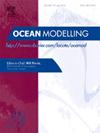On the directional distributions of the observation-based wind input and dissipation terms in a third-generation wave model
IF 2.9
3区 地球科学
Q2 METEOROLOGY & ATMOSPHERIC SCIENCES
引用次数: 0
Abstract
New observation-based directional spreading functions for the wind input term and the dissipation term have been investigated in third-generation wave models (WAVEWATCH III, ST6 version). In this study we evaluate bimodal directional distribution for and narrower ( and ) distributions for . The impact of these new directional functions on the integral wave parameters, as well as the nondirectional and directional spectra, is analyzed through a set of numerical experiments and their results are compared against buoy observations in the Caribbean Sea. Improvements in the estimation of and under wind-sea dominant conditions are presented. For the shape of frequency spectra, the bimodal distribution of causes a weaker energy enhancement by comparison with the narrower distribution of , but it generally shows a better fit than the default functions in the model. The combined effect of both modifications brings larger energy allocation around the main wave propagation direction, generating both an energy increase and a downshift at the spectral peak. These findings suggest the relevance of including realistic directional distributions and reveal the need for further studies of directional distributions of the source terms.
第三代波浪模式中基于观测的风输入和耗散项的方向分布
在第三代波浪模型(WAVEWATCH III, ST6版)中,研究了新的基于观测的风输入项Sin和耗散项Sds的方向扩展函数。在本研究中,我们评估了Sds的双峰方向分布和Sin的较窄(cos2θ和cos4θ)分布。通过一组数值实验,分析了这些新的方向函数对积分波参数以及非方向性和方向性谱的影响,并将结果与加勒比海浮标观测结果进行了比较。提出了在风-海优势条件下估算Hs和Tp的改进方法。在频谱形状上,Sds的双峰分布对能量的增强作用较Sin的窄分布弱,但总体上比模型中默认函数的拟合要好。两种修正的共同作用使主波传播方向周围的能量分配更大,在谱峰处产生能量增加和下移。这些发现表明了包括现实方向分布的相关性,并揭示了进一步研究源项方向分布的必要性。
本文章由计算机程序翻译,如有差异,请以英文原文为准。
求助全文
约1分钟内获得全文
求助全文
来源期刊

Ocean Modelling
地学-海洋学
CiteScore
5.50
自引率
9.40%
发文量
86
审稿时长
19.6 weeks
期刊介绍:
The main objective of Ocean Modelling is to provide rapid communication between those interested in ocean modelling, whether through direct observation, or through analytical, numerical or laboratory models, and including interactions between physical and biogeochemical or biological phenomena. Because of the intimate links between ocean and atmosphere, involvement of scientists interested in influences of either medium on the other is welcome. The journal has a wide scope and includes ocean-atmosphere interaction in various forms as well as pure ocean results. In addition to primary peer-reviewed papers, the journal provides review papers, preliminary communications, and discussions.
 求助内容:
求助内容: 应助结果提醒方式:
应助结果提醒方式:


